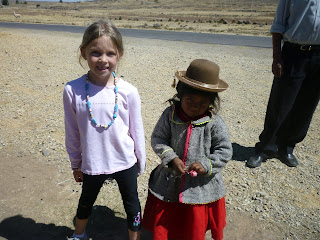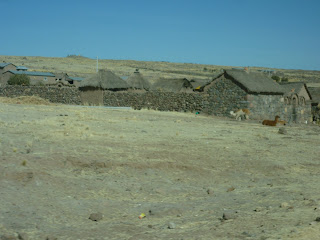
Felix, our guide for the Puno part of our trip, is Quechua Indian. He was born and reared in the Puno area, in fact, quite near Sicuani. He speaks Quechua, Spanish, and he is teaching himself German so he can guide German speaking tourists. He knows many of the families near the Inca burial towers. He asked friends, also Quechua, if he could bring by our family to meet them so we could have a personal experience. This is the family's homestead from the back. I noticed it as we were driving toward Sicuani. Little did I know we would be visiting the home.
This is the family's homestead from the back. I noticed it as we were driving toward Sicuani. Little did I know we would be visiting the home.
 This is the family's homestead from the back. I noticed it as we were driving toward Sicuani. Little did I know we would be visiting the home.
This is the family's homestead from the back. I noticed it as we were driving toward Sicuani. Little did I know we would be visiting the home. Three generations share this home. The grandfather is weaving a rug. The mother of the little girl is standing against the door of her bedroom. The room is simply furnished--just a bed and hooks to hang a few clothes.
Three generations share this home. The grandfather is weaving a rug. The mother of the little girl is standing against the door of her bedroom. The room is simply furnished--just a bed and hooks to hang a few clothes. The family built their own home after the manner of their ancestors--simple stone walls, stone patios, adobe walls and arch. They even made the ceramic pigs which adorn the arch.
The family built their own home after the manner of their ancestors--simple stone walls, stone patios, adobe walls and arch. They even made the ceramic pigs which adorn the arch. We were taken by the two pigs which seem to be welcoming us.
We were taken by the two pigs which seem to be welcoming us.  The family grows several different kinds of potatoes or papas. The bowl in the center holds "clay" which we were invited to taste. All the potatoes and vegetables are dipped into the clay. It tastes like a salty clay.
The family grows several different kinds of potatoes or papas. The bowl in the center holds "clay" which we were invited to taste. All the potatoes and vegetables are dipped into the clay. It tastes like a salty clay. Emma, Spencer, and Kate were fascinated by the clay idea and the potatoes were really tasty. We peeled the potatoes first.
Emma, Spencer, and Kate were fascinated by the clay idea and the potatoes were really tasty. We peeled the potatoes first. Margaret and Kate wanted to have a picture with the llama but the llama wouldn't look at the camera.
Margaret and Kate wanted to have a picture with the llama but the llama wouldn't look at the camera. The little girl and Kate are both 7. She was so shy, but she surprised us by asking for a dulce or caramelo (a piece of candy) as we were getting out of the van. Fortunately I had some M & Ms from tropical trail mix to give her. We also paid the family for letting us visit them. It's customary. I don't have a picture of their homemade goods for sale. I'd have loved to buy a rug but the father wanted 150 soles or the equivalent of $50 which isn't a bad price, but it was at the beginning of our trip and we had no extra room in our carry-on luggage. I did buy a small ceramic vase.
The little girl and Kate are both 7. She was so shy, but she surprised us by asking for a dulce or caramelo (a piece of candy) as we were getting out of the van. Fortunately I had some M & Ms from tropical trail mix to give her. We also paid the family for letting us visit them. It's customary. I don't have a picture of their homemade goods for sale. I'd have loved to buy a rug but the father wanted 150 soles or the equivalent of $50 which isn't a bad price, but it was at the beginning of our trip and we had no extra room in our carry-on luggage. I did buy a small ceramic vase. Kate's alpaca was more cooperative. Their wool is so soft. There is nothing softer than baby alpaca. A good quality baby alpaca sweater is fairly expensive.
Kate's alpaca was more cooperative. Their wool is so soft. There is nothing softer than baby alpaca. A good quality baby alpaca sweater is fairly expensive. The grandfather wanted to show us all about their family life. He was really good with the kids. This alpaca is really cute--His facial expression was like that of a loving, happy puppy.
The grandfather wanted to show us all about their family life. He was really good with the kids. This alpaca is really cute--His facial expression was like that of a loving, happy puppy.
Felix explained that the grandmother does all the cooking. In good weather they use their outdoor kitchen. During the rainy season, they cook in the windowless inside kitchen which is behind Felix.
 The little girl would have nothing to do with the hat her mother wanted her to wear. She went into the house and chose one of her own. Little girls are the same everywhere.
The little girl would have nothing to do with the hat her mother wanted her to wear. She went into the house and chose one of her own. Little girls are the same everywhere. Grandmother demonstrated grinding grain for bread. The method of grinding corn, wheat, or quinoa is the same as the North American Indians use. They served a coarse, quinoa biscuit which was really tasty.
Grandmother demonstrated grinding grain for bread. The method of grinding corn, wheat, or quinoa is the same as the North American Indians use. They served a coarse, quinoa biscuit which was really tasty. We enjoyed this experience so much. We were much more than tourists while we were there. We were honored guests. Emma, Spencer, and Kate will take with them a rich understanding of the Quechua culture.
We enjoyed this experience so much. We were much more than tourists while we were there. We were honored guests. Emma, Spencer, and Kate will take with them a rich understanding of the Quechua culture.











































